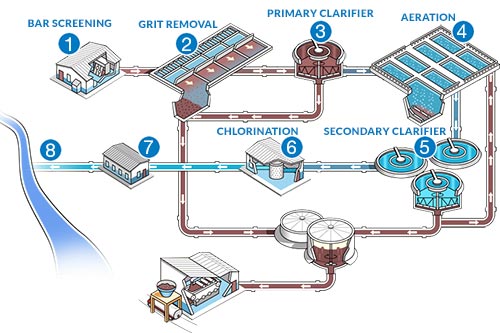Exploring Innovative Developments in Wastewater Technology
Exploring Innovative Developments in Wastewater Technology
Blog Article
Comprehending Wastewater Treatment Processes and Their Ecological Impact
The intricacies of wastewater therapy processes play a critical role in mitigating environmental obstacles linked with water air pollution. Each phase, from preliminary to sophisticated therapies, is developed to attend to specific pollutants, ultimately protecting both public health and wellness and water environments.
Review of Wastewater Treatment
Exactly how is wastewater changed right into a secure resource for the atmosphere? Wastewater treatment is a vital process designed to get rid of pollutants from used water, therefore protecting public wellness and protecting ecological communities. This procedure begins with the collection of wastewater from residential, commercial, and commercial resources, which is then routed to therapy facilities.
At these centers, different physical, chemical, and biological approaches are employed to deal with the wastewater. Preliminary testing gets rid of huge particles, complied with by sedimentation to different larger solids. Ultimately, biological therapies, such as turned on sludge processes, utilize bacteria to break down natural matter. These techniques not just reduce contaminant levels however also assist in the recovery of useful nutrients.
The treated effluent can be safely discharged right into natural water bodies or reused for watering and commercial purposes, promoting resource preservation. Additionally, the treatment procedure creates biosolids, which can be repurposed as fertilizers or soil changes, additionally enhancing sustainability.
Stages of Treatment Procedures
The wastewater therapy procedure commonly includes three key phases: initial, primary, and secondary treatment. Each phase offers a distinctive role in decreasing the contaminant lots and guaranteeing the effluent satisfies environmental requirements before discharge.

The main treatment stage focuses on the physical separation of suspended solids from the wastewater. With sedimentation, larger fragments resolve at the end of sedimentation containers, creating sludge, while lighter products, such as oils and oils, float to the surface and are skimmed off. This procedure significantly reduces the natural and not natural tons in the wastewater.
Additional treatment is a biological procedure focused on more reducing the focus of raw material. Various approaches, consisting of triggered sludge systems and trickling filters, make use of bacteria to metabolize organic contaminants. This stage is necessary for achieving the necessary biochemical oxygen demand (FIGURE) reduction, eventually leading to cleaner effluent all set for discharge or additional treatment. Each phase is important in securing environmental and public wellness.

Advanced Treatment Technologies
Adhering to the secondary therapy processes, progressed therapy innovations play an essential function in more enhancing the high quality of treated wastewater. These modern technologies are developed to get rid of residual pollutants that are not effectively gotten rid of throughout primary and additional therapies, ensuring the effluent satisfies rigorous regulatory requirements.
Amongst the widely used innovative treatment methods are membrane layer filtration, reverse osmosis, and progressed oxidation procedures. Membrane layer filtration, including microfiltration and ultrafiltration, is reliable in dividing great particles, microorganisms, and colloids from the water (Wastewater). Reverse osmosis uses semi-permeable membrane layers to eliminate dissolved solids, leading to high-quality water appropriate for different applications
Advanced oxidation procedures (AOPs) use solid oxidants to degrade organic pollutants, including pharmaceuticals and individual treatment items that are immune to conventional treatment. These methods enhance the biodegradability of complicated compounds, facilitating their removal.
One more considerable modern technology is the usage of organic Learn More Here nutrient elimination procedures, which especially target nitrogen and phosphorus, protecting against eutrophication in getting water bodies. Generally, innovative treatment modern technologies are necessary for attaining greater degrees of filtration, promoting water reuse, and securing public health while addressing the obstacles related to wastewater monitoring.
Ecological Benefits of Therapy
Various environmental benefits develop from efficient wastewater therapy processes that contribute to ecosystem health and Look At This sustainability. Primarily, these procedures dramatically lower the launch of dangerous contaminants into all-natural water bodies, which assists preserve aquatic ecosystems. By getting rid of impurities such as heavy metals, nutrients, and virus, dealt with wastewater reduces the risk of waterborne conditions and advertises biodiversity in marine settings.
Additionally, wastewater therapy centers typically employ innovative innovations that enable water recycling and reuse. This technique not only preserves freshwater sources however additionally minimizes the demand on all-natural water supplies. Improved nutrient removal from wastewater can likewise prevent eutrophication, a procedure that results in algal blossoms and succeeding oxygen deficiency in aquatic systems.
In addition, efficient therapy procedures can minimize greenhouse gas discharges, especially methane and nitrous oxide, which are typically launched during unattended wastewater decomposition. By catching and utilizing biogas from anaerobic digesters, facilities can transform waste right into renewable resource, therefore contributing to a decrease in nonrenewable fuel source reliance.
Obstacles and Future Trends
While the environmental advantages of wastewater therapy are clear, several difficulties persist that hinder optimum outcomes in this field. more One significant concern is aging infrastructure, which commonly leads to ineffectiveness and enhanced functional prices - Wastewater. Several treatment plants were developed years earlier, and their capacities do not align with modern demands, which consist of more stringent regulatory standards and higher volumes of wastewater because of urbanization

Looking in advance, there is a growing emphasis on source healing and circular economy concepts within wastewater treatment. Innovations such as anaerobic food digestion, which can create biogas, and advanced purification technologies are gaining grip. These methods not just improve treatment effectiveness but additionally promote sustainability.
Inevitably, resolving these difficulties calls for partnership among stakeholders, financial investment in technology, and a dedication to ongoing study. By embracing these fads, the wastewater treatment market can evolve to fulfill the demands of a transforming environment and culture.
Conclusion
In final thought, wastewater treatment processes play an essential duty in boosting environmental high quality and public wellness. The multi-stage therapy framework, paired with innovative modern technologies, effectively reduces contamination and promotes sustainable water administration.
Report this page